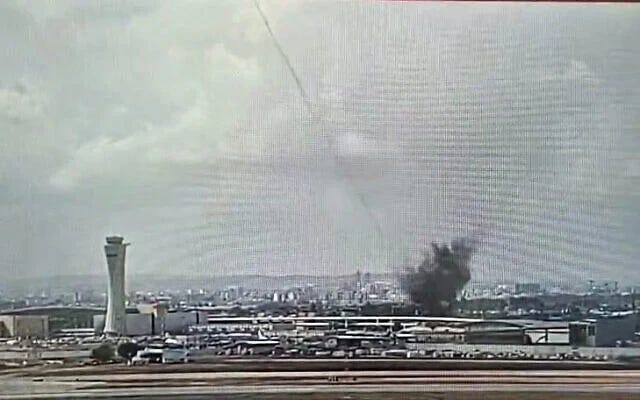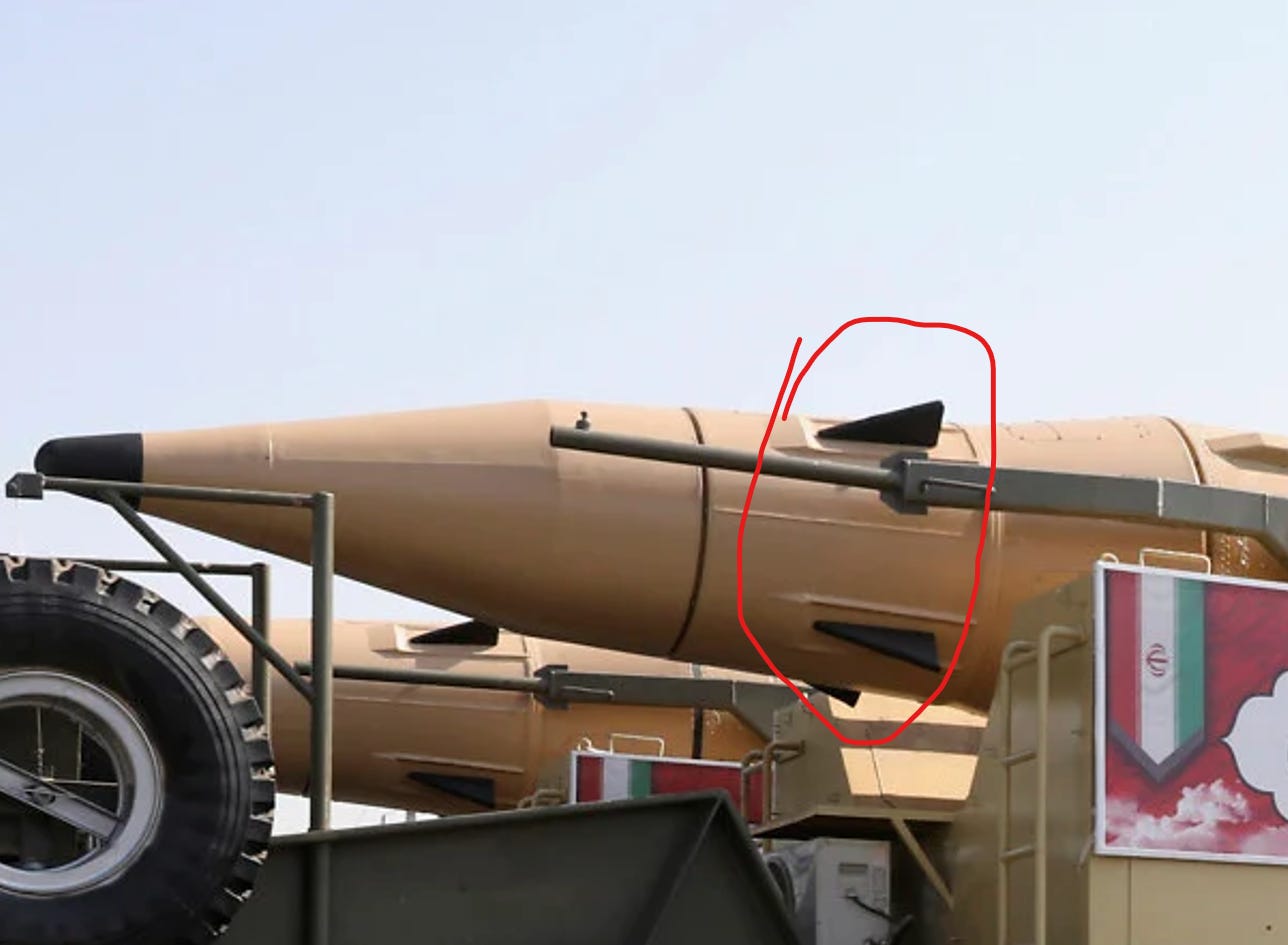Don’t ever accuse me of being timely. Yes, this happened a month ago. Yes, I started writing this like two days after it happened. However, I also went on vacation. At long last:
On the morning of May 4, 2025, the grounds of Ben Gurion Airport in Central Israel was struck by a ballistic missile fired from Yemen. This was neither the first time Ben Gurion has been hit by something during the war of the last 18 months, nor the first time a missile from Yemen pierced through all layers of missile defense to hit Israel. But, nonetheless, the combination of political factors and timing turned it into a very impactful story.
What do we know for certain about this missile attack?
Not a lot. We know when it happened. We know where it hit. And beyond that, we have a lot of claims and speculation. First - where did it hit? It struck an open area near one of the access roads below the main parking area and terminal.
We also have some bystander footage of the impact, helpfully compiled via The Times of Israel at the top of this article. I can’t embed videos in Substack, apparently - or I don’t know how - so if you want to see some handheld footage of a big explosion and smoke, as well as a CCTV clip of the missile zipping through the overcast sky and impacting behind the airport control tower, go ahead and navigate over and check it out. Screenshot of the last one below.
Also noted in that article is the claim from the Israelis that the missile bypassed both the Arrow and THAAD ballistic-missile defense systems in place designed to intercept and destroy such missiles. Here’s where things start to get a little bit interesting.
Firstly, the claim itself is obvious - if the missile hit, clearly it wasn’t intercepted. But I want to examine a few related points here, and briefly talk about Israeli missile defense.
Discerning readers will notice that I have barely mentioned “Iron Dome” in any of my articles so far. That trend will continue, once I explain why. The Iron Dome is by far the most well-known defensive system used in Israel, but the short story is this - the Iron Dome is not designed or used to intercept ballistic missiles. The Iron Dome is used to intercept small, low-altitude, low-speed projectiles that generally follow a predictable ballistic arc - or close enough. This would include the rockets cobbled together from anything available launched out of Gaza, or the basic military-grade rockets launched by Hezbollah and other actors from southern Lebanon.
Image source: NPR
Many people may have seen an image like this in articles that mention the Iron Dome, or with titles like “Rockets launched from Gaza.” There are many such photos, they are long-exposure photos that show quite well how Iron Dome works. On the left is four Iron Dome launchers firing off a number of Tamir interceptor missiles (to note - the U.S. Department of Defense buys Tamir interceptor missiles at a unit-cost of $180,000 apiece). The missiles are fired when a rocket launch is detected by a central radar, and the missiles are then positioned in the air where the rockets are predicted to pass through, and then use the small active seeker radar in the missile itself to perform the final maneuvers to find and hit the incoming rocket.
On the right of the image is the barrage of incoming rockets. The long-exposure photo helps show that they follow a fairly predictable arc, barring a malfunction, and fly relatively low to the ground. Their maximum range is a usually not much more than a few kilometers, and they don’t weigh that much - maybe a few hundred pounds at most, and most weigh far less than that, as they are mostly transported by hand.
Iron Dome can also shoot down things like small, slow-moving drones and the like. But its basic purpose is shooting down small, lightweight objects.
An incoming ballistic missile of the sort fired from Yemen or Iran is neither small nor lightweight. For example, the elder statesman of Iranian missiles, the Emad, has a weight at launch of 19,000kg (about 42,000lb for Americans) and is 16m long (54ft for Americans).
The part that actually hits the ground - and thus needs to be intercepted - carries an explosive payload of 750kg (over 1600lb for Americans). That’s just the explosives, not the guidance system, or the metal shell that has to withstand the heat of re-entering Earth’s atmosphere. Because at the ranges necessary to hit Israel from Iran or Yemen, these missiles fly high enough to essentially go into space. When they re-enter the atmosphere, they reach speeds clocking in the thousands of miles per hour, just from gravity alone. More modern missiles, such as the Iranian Fattah series, have a secondary rocket booster in the warhead to further accelerate, reaching extreme speeds.
Image source: The Times of Israel
See above an Emad missile resting in its truck-based launch vehicle. The circled part is the warhead.
The Tamir interceptor is about 3m long and weighs 90kg. It’s not gonna do the job.
But one claim about Israeli missile defense that does stick around is the idea (from the Iron Dome) that the radar calculates where the missile is going to land, and only engages those with a chance to hit populated areas or sensitive targets. Basically, it only wastes an interceptor missile to intercept something that might actually do damage. If an incoming enemy missile is going to just hit an empty field, it is allowed to do so.
This claim has been used during each of the many missile attacks against Israel in the last year and a half. This claim is, in fact, true of the Iron Dome - at least, when the projectile is a simple light rocket on a ballistic trajectory.
But, while it isn’t confirmed to be untrue of the ballistic missile defense systems at play - Arrow, THAAD, and David’s Sling - it is very likely untrue. Firstly, the missile this article is about did hit a sensitive area, and did cause at least six injuries. If its trajectory had changed by even half a degree, it would have impacted dead center in the airport terminal, and could have killed or injured dozens, even hundreds of people. Secondly, Israel confirmed that they engaged the incoming missile with Arrow interceptors, which failed. They also claimed the Americans engaged it with THAAD interceptors, which also failed.
But beyond this one, there’s a very good reason why it is likely that Israel engages and attempts to intercept every incoming ballistic missile. These missiles almost universally possess maneuverable reentry vehicles (MaRVs). This term, MaRV, essentially means the missile warhead has little steering fins that can make adjustments to the trajectory of the warhead as it descends towards its target.
Looking at our friend the Emad again and those fins are quite visible. The Emad is one of the oldest missiles with the range to hit Israel that Iran still has operational. Every newer missile in their inventory also are equipped with MaRVs.
What this means in terms of missile defense is that Israel does not know exactly where the missile is going to land until it lands. At the speed these missiles travel, one tiny adjustment of those fins can change the impact point by a mile or more.
So, point being - Israel engaged the incoming missile and failed. Israel claims the THAAD system that the U.S. military operates in Israel also engaged the incoming missile and failed. According to this article (also linked above), Israel claims that their identification and launch worked fine - that is to say, they were not surprised by the arrival of the missile, and they launched interceptor missiles at it with the intention of shooting it down. They claim the interceptor missile that was fired had a “pinpoint technical malfunction,” which is a meaningless statement. I’m not going to read too much into the use of the singular “interceptor” rather than “interceptors” because it is unknown how many interceptor missiles were launched, but likely more than one. Also not mentioned is how many THAAD interceptor missiles were launched by the U.S. military.
Now I want to examine claims from the other side - the group commonly known as the Houthis, formally known as Ansarallah, claimed the attack. In their statement, they claim to have used a hypersonic missile to achieve the hit.
The term “hypersonic” is a bit of a buzzword in the military technology world - kind of like “AI-enabled” - it’s approaching meaninglessness. It does have a literal meaning: a missile that travels in excess of Mach 5, or five times the speed of sound, or roughly 3800mph. For reference, an average Boeing 737 airliner cruises a bit past 500mph. A fighter jet might spend brief periods in excess of 1000mph, but will mostly cruise somewhere below 700mph. A bullet fired from an M-16 rifle travels a little past 2,000mph. Bottom line - it goes really really fast.
The reason it’s a buzzword, however, is that large enough ballistic missiles have been reentering the atmosphere and hitting the ground at hypersonic speeds for quite some time. It’s not exactly a new technology - you launch something big enough up into space, it’s going to come back down again screaming fast. It’s not publicly known exactly how fast these various Iranian-designed missiles are traveling when they hit the ground, but it’s not a stretch to imagine that they very well may be hypersonic. This Wall Street Journal article makes passing reference to Houthi anti-ship missiles “traveling at nearly 4,000 miles per hour.” This is specifically in reference to their anti-ship ballistic missiles, which is an interesting note to make (presumably sourced from the U.S. military) as the missiles in question are likely derivatives of the Iranian Fateh-110 short-range ballistic missile, such as the Khalij Fars or Zolfaghar Basir, both much smaller than the missiles launched at Israel and none of which are reported to be hypersonic. So the U.S. military is essentially confirming that the Houthis are using anti-ship ballistic missiles with capabilities in excess of what is currently known publicly. Nice!
As a result of the above, when “real” military-heads talk about hypersonic weapons, they’re talking about a hypersonic glide vehicle, or HGV. This does in fact represent a genuinely new form of technology that is at the cutting edge of weapons development. An HGV is capable of reaching, cruising, and maneuvering at hypersonic speeds during level flight while in Earth’s atmosphere. This has a number of advantages, but luckily this graphic from Wikipedia will help us out:
Bottom line - when a HGV is detected by the target’s radar, it’s already too late to do anything about it. A ballistic missile, no matter how fast it’s going, will be detected early enough in its flight that the target will have some time to prepare.
In terms of who actually possesses such weapons -HGVs, that is - the list is quite short. The People’s Republic of China is the main one. Russia and India have developed a series of anti-ship cruise missiles that achieve hypersonic speeds. North Korea claims to have developed one. The U.S. is developing its own versions. And, well…
… Iran. Sort of. The Fattah-2 missile system appears to be a HGV, or close enough. Whether the missile is in operational use yet is very much a question, as it is arguably the most cutting edge and advanced in Iran’s arsenal. Interestingly, Mehr News Agency claimed these were used to knock out Israeli Arrow missile defense batteries during the October 1, 2024 missile attack - but I don’t think that’s true. Or at least, I suspect it isn’t true. For one thing, the missile shown in the image is a Fattah-1, which looks very different. If I had the money to buy my own Maxar satellite pictures I could get a pretty good idea though. Don’t forget to subscribe.
Bottom line - theoretically, the technology transfer from Iran to Ansarallah in Yemen could include the Fattah-2 missile. Frankly, I don’t buy it. For one thing, the Fattah-2 has a fairly small warhead, and the missile that impacted Ben Gurion had a whopper of a warhead. The crater was huge - this missile had a warhead with a weight in the hundreds of kilos. The Fattah-2 warhead is quite small, relying on speed and precision rather than sheer explosive force.
Here’s the crater.
Now, they could have transferred the Fattah-1 to Yemen. This one has been called “hypersonic” before, but it’s not “true” hypersonic in the sense I’ve been talking about. It’s a traditional ballistic missile, it’s just designed to re-enter the atmosphere and impact at exceptionally high speed.
This is all just splitting hairs and arguing semantics, but essentially the Houthi announcement used a buzzword designed to sound cool but doesn’t necessarily mean anything significant. Every missile they’ve fired at Israel is “hypersonic” in the most literal sense.
So why does this all matter, anyway? It matters because it shows that a semi-state actor can hit targets from nearly 2,000 kilometers away in the most well-defended airspace on Earth with relatively cheap and simple weapons that can be assembled locally from smuggled components. The cost of the THAAD and Arrow and David’s Sling defense systems deployed by the U.S. and Israel is astronomical, both in terms of research and development and per-missile unit cost. The missiles used by the Houthis and Iran aren’t cheap, per se, but they are relatively extremely cheap. The simple fact that Iran can develop these weapons and deploy them en masse is proof that they are not massively expensive, as Iran is not a fabulously wealthy state with an even more fabulously wealthy benefactor covering most of the costs. Many Iranians would probably prefer the government spend this money elsewhere, but Iran is not bankrupting itself with this missile program. Nor, of course, is Israel bankrupting itself building Arrow 3 interceptor missiles, but due to their high cost and technical sophistication, it is simply unable to build enough of them to be able to withstand a true massed attack, let alone one that uses methods (such as the Fattah-2’s HGV characteristics) that simply bypass the Arrow 3’s interception window entirely. The missile defense calculus does not add up in Israel’s favor.
Israel has long used missile defense (primarily the Iron Dome defending against rockets from Hezbollah and Hamas) to insulate itself from having to use policy, strategy, or diplomacy to solve it’s problems. If it can do whatever it wants with regards to Gaza or Lebanon and only spend a few hundred million a year on the Iron Dome system and not concede anything or engage in any diplomacy, that’s great.
But the introduction of these Iranian ballistic missiles into the equation has changed the game, and it’s unclear what the long term impacts of this will be. Already Iran’s twin ballistic missile operations in April and October of 2024 have had significant political impacts (even if nobody in Israel or the U.S. is willing to admit it), and the Houthi’s regular missile attacks on Israel have also had a significant political impact.
Bottom line - Israel’s missile defense can no longer substitute for diplomacy. Something’s gotta give.











